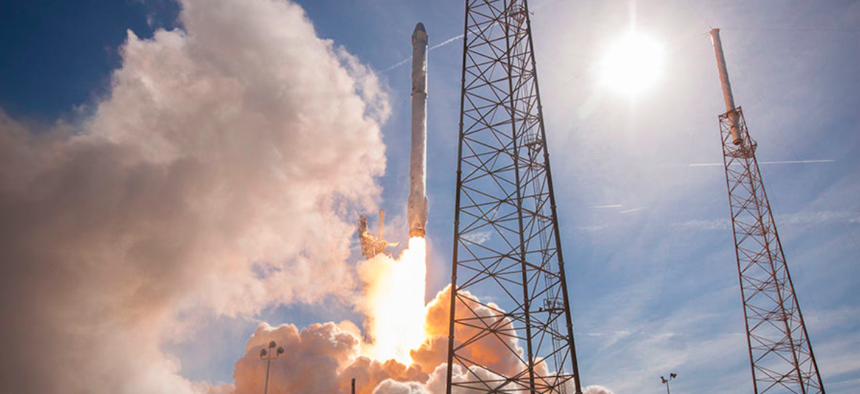
The initial launch of SpaceX's first re-flown rocket is shown here. SpaceX
What SpaceX's Record-Breaking Year Means for Science (and the Rocketry Business)
After a triumphant year, the reusable rocketeer is planning 50 percent more launches in 2018.
The year 2017 has turned out to be a good one for rocket science in the United States.
American companies made 29 successful rocket launches into orbit, the highest figure since 1999, which saw 31 launches, according to a comprehensive database maintained by Gunter Krebs, a spaceflight historian in Germany. The final launch of the year, by a SpaceX Falcon 9 rocket carrying a cache of commercial communications satellites, took place Friday night at Vandenberg Air Force Base in California.
SpaceX, Elon Musk’s private spaceflight company, is responsible for most of this year’s launches. After a brief hiatus following an explosion in September 2016 that destroyed a Falcon 9 and its $200 million commercial payload, SpaceX returned to the launchpad in mid-January. At the time, the success of the launch was imperative; SpaceX had lost another rocket in June 2015, about two minutes after takeoff, and its rocket-fueling process was receiving intense scrutiny by a nasa safety advisory group. nasa was entering its fifth year of using SpaceX rockets for resupply missions to the International Space Station, and future deals were on the line.
The launch went smoothly. Another successful attempt followed in February, and then two more in March. Observers held their breath as the months progressed, hopeful for a streak but unwilling to call attention to it, lest they jinx the whole thing. But the streak continued, and SpaceX launched a variety of payloads—commercial satellites, International Space Station cargo, even supersecret missions for the U.S. government—at a regular cadence throughout the year.
Despite an explosion of one of its rocket engines during a test at its facility in Texas in November, SpaceX ended the year without any in-flight failures or launchpad explosions. The company’s total comes to 18 launches in 2017—its most in a single year, and more than double that of the previous year.
The streak has made rocket launches by a commercial company from U.S. soil seem routine and almost ordinary—though someone probably should have warned the people of Los Angeles, many of whom were confused or terrified at the sight of the exhaust plume from Friday’s launch, which took the shape of a ghostly spaceship in the night sky.
It has been just two years since SpaceX launched a Falcon 9 into orbit and then returned the rocket’s first-stage booster back to Earth, landing it upright on the ground. And although there were a few spectacular fiery fails before and after this attempt, the recovery of a Falcon 9’s first stage, whether on land or on a drone ship at sea, seems, by now, a regular occurrence.
But landing a rocket stage after launch is only the first part of a truly reusable rocket regime. In March of this year, SpaceX made good on the second part when it used a refurbished first stage, previously flown in 2016, to launch a communications satellite. The first stage returned to Earth, touching down on a drone ship in the Atlantic Ocean. It was the first time SpaceX had launched a “flight-proven” rocket, the promise of which led Musk to create the company in the first place. In November, nasa agreed to let SpaceX use refurbished rockets in its resupply missions to the International Space Station. Earlier this month, a used rocket did just that, launching 5,000 pounds of crew supplies and science experiments.
The last year has placed commercial companies like SpaceX and Blue Origin, Amazon founder Jeff Bezos’s firm, squarely in the age of reusable rockets. While nasa builds an expendable heavy launch system for astronauts of the future, the rest of the market has decisively moved away from disposal rockets, and private firms are jockeying to be the top brand in the field. Blue Origin beat SpaceX to reusability in November 2015, when the company launched its New Shepard rocket into Earth’s atmosphere, breached the edge of space, and parachuted back down, landing vertically. Musk and others quickly, and correctly, pointed out that while Bezos’s rocket had made it to the Kármán line, the boundary that separates the atmosphere and outer space, it had not reached orbit. Blue Origin has tested the New Shepard several times this year, but hasn’t yet achieved orbital flight.
SpaceX said it plans to significantly increase the number of launches in 2018. “We will increase our cadence next year about 50 percent,” Gwynne Shotwell, the company’s president and COO, told SpaceNews in November. “We’ll fly more next year than this year, knock on wood, and I think we will probably level out at about that rate, 30 to 40 per year.” The company also said it would start construction next year on the BFR, a behemoth of a rocket that Musk said in September would someday replace its current fleet of spacecraft in sending payloads—and eventually people—into low-Earth orbit and beyond.
SpaceX will begin the new year as it began 2017, with another high-stakes launch. After some delay and much hype, the company plans to launch its Falcon Heavy rocket, a reusable, behemoth version of the Falcon 9 capable of lifting more than twice the payload of the Delta IV Heavy, the most powerful heavy-lift launch vehicle in operation. The Heavy is a throwback to the power of the Saturn V, the rocket that sent astronauts to the moon and Skylab, the first U.S. space station, into orbit in the 1960s and 1970s.
Musk has said he’s not sure if the flight will be a success. “I hope it makes it far enough away from the pad that it does not cause pad damage,” he said at a conference in July. “I would consider even that a win, to be honest.”
For its maiden flight, the Falcon Heavy will carry one of Musk’s cherry-red Tesla roadsters, in quite the show of cross-platform promotion. The rocket will blast off from a launchpad SpaceX leases from nasa, at Cape Canaveral in Florida—the historic site of launches for the Apollo program, the Space Shuttle program that built humans a home in orbit, and, in this case, an attempt to make big rocket launches a routine thing.




